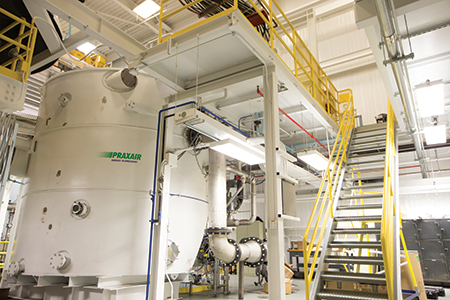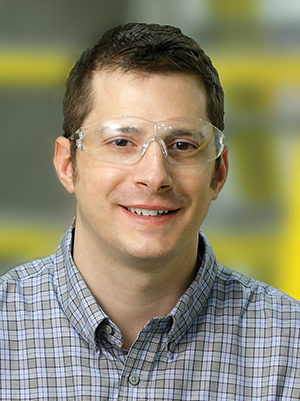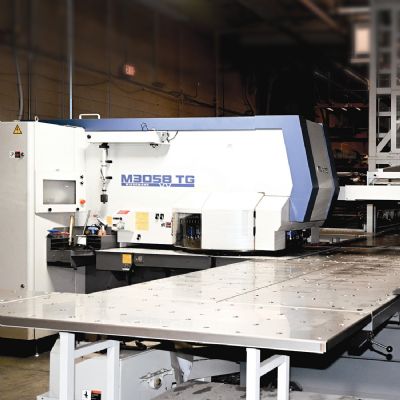Titanium Taking Off
August 5, 2016Comments
From bicycles to airframe and engine parts, from automotive structures to dental implants, additive manufacturing with titanium powders is taking off. Called a “miracle metal” in some circles for its unique combination of properties, titanium and its cast and wrought alloys offer designers solutions to often challenging combinations of requirements for strength, shape memory, corrosion resistance and biocompatibility.
At the same time, however, titanium alloys can prove quite difficult to fabricate and machine, and often are referred to as “difficult-to-machine” materials. Basic challenges fabricators face when machining titanium include chip-thickness variability, heat stress, springback and buildup of residual stresses. Cutting tools can wear quickly and unpredictably, and high-quality machined surfaces can be difficult to acheve. Better Buy-to-Fly solutions to overcome many of these challenges are available for fabricators, but at a high cost. So while machining of titanium can be a quite costly proposition, manufacturers do it all the time. This leads us to another issue that plagues the aerospace industry, and others manufacturing with titanium: the ‘buy-to-fly ratio’ that aircraft producers refer to is quite high. A fabricator might purchase 100 lb. of titanium, for example, and machine away 90 percent of it to make a part, turning expensive metal into chips for a buy-to-fly ratio of 10:1 (in this case). A more efficient option: additive manufacturing, which offers buy-to-fly ratios closer to 1:1. And, when it comes to lightweighting applications where titanium parts are required to interface with carbon-fiber material, titanium’s special corrosion properties make it the material of choice. Titanium is very compatible with carbon fiber, while aluminum alloys and some steels are not. According to the Corrosionpedia website, “aluminum alloys are extremely vulnerable when they are coupled to a carbon composite,” as are carbon steels. Meanwhile, titanium’s dense, stable and protective oxide layer prevents a galvanic reaction when coupling titanium to carbon composites.Capacity Online to Meet this High-Growth MarketAll of this adds up to a tremendous amount of interest in titanium-powder technology for additive-manufacturing applications. So says Andy Shives, market development manager for Praxair Surface Technologies, a manufacturer of gas-atomized metal powders that recently launched an additive-manufacturing division in Indianapolis, IN, to satisfy what it sees as a high-growth market.“Gas-atomized powders that traditionally are used for thermal-spray coatings,” says Shives, “are gaining favor for additive manufacturing.” Suppliers of the powders can adjust the composition to optimize them for specific applications. For additive applications, very fine powders can be atomized for use in laser powder-bed machines, and coarser particle sizes for electron-beam powder beds. Last August, Praxair Surface Technologies announced its launch of newly expanded operations geared toward production of high-purity fine, spherical titanium powder for additive manufacturing. Traditionally a supplier of atomized superalloys of nickel and cobalt, the firm’s ability to now produce large-scale volumes of titanium powder promises to help support what has become a rapidly expanding market.Unique to Praxair is the adoption of new gas-atomization technology developed recently at Ames Laboratory, a DoE facility operated by Iowa State University. That technology (a specialized nozzle) eventually was licensed to spinoff company Iowa Powder Atomization Technologies (IPAT). IPAT, created by Ames Laboratory researchers Joel Rieken and Andrew Heidloff, was acquired by Praxair Surface Technologies in 2014; Heidloff and Riecken joined Praxair as development specialists.“We’re the first to employ close-coupled gas atomization for titanium,” Heidloff tells 3D Metal Printing, “which is the optimum process for making powders fine for additive manufacturing. The nozzle that conveys the liquefied titanium through the high-velocity atomization gas is the key to the process, allowing the temperature of the metal to increase to superheating range—100-150 deg. above melting temperature.”Documented Metal-AM ResultsWhile the overwhelming majority of titanium-related additive-manufacturing projects remain under wraps, several have recently been documented. Included is the 3D printing of titanium-aluminide rotor wheels for use in automotive turbochargers, using Arcam’s electron-beam-melting technology. The new turbochargers, compared to those currently fabricated from conventional nickel superalloys, promise to reduce weight by 60 percent and mass by 36 percent, while improving vehicle efficiency by 5 percent and reducing CO2 emissions by 8 percent. Arcam’s electron-beam melting of titanium also has received notoriety related to additive manufacturing of jet-engine turbine blades for the GE Aviation LEAP engine, developed by CFM Intl. GE states that one Arcam machine can manufacture eight turbine blades in 7 hr., thanks to the ability of the electron-beam machine to build up layers of powder that are more than four times thicker than those produced by laser powder-bed machines. This on the heels of GE’s opening of a 300,000-sq.-ft. plant in Auburn, AL, where more than a dozen laser-melting 3D printing machines produce LEAP fuel nozzles.Most recently, the new Airbus A380 is powered by the Rolls-Royce Trent XWB-97 engine, which features a prototype front bearing housing (1.5-m dia. by 0.5 m thick) containing 48 airfoils 3D printed (using Arcam technology) from titanium.Additionally, visitors to the Consumer Electronics Show in Las Vegas earlier this year got to see the 3D-printed titanium bicycle frame produced by Tokyo-based Cerevo Inc. It, like so many aircraft applications, marries titanium to carbon-fiber components. And, finally, the U.S. Navy’s latest unmanned combat aerial surveillance system (the X-47B) features a warm-air mixer (fabricated by Simi Valley, CA-based additive manufacturer CalRam, Inc.) using Arcam’s electron-beam process. The complex component, described in a recent article in Aerospace Engineering, is made from one piece by 3D printing Ti-6Al-4V powder. The benefits: part-count reduction and the elimination of welding of multiple parts, as well as reduced costs and a shortened delivery schedule.Out-of-the-Box DesigningTi-6Al-4V is one of the three titanium powder compositions offered by Praxair Surface Technologies for additive manufacturing, the others being titanium aluminide (Ti-48Al-2Nb-2Cr), and Ti6242 (Ti-6Al-2Sn-4Zr-2Mo).“Our Ti-6A1-4V materials are by far the biggest sellers of the three products,” says Shives. “In terms of what we see coming down the road,” he adds, “we expect to see significant growth in design complexity in several end-use application areas. Additive manufacturing with titanium and other metal alloys allows designers to think out of the box and develop more organic-looking shapes that give fresh perspectives to functionality and performance.” Heidloff adds:“We’ll see more opportunities to combine multiple parts into one functional design while providing lightweighting and strength advantages. We expect our core group of three titanium-alloy additive-manufacturing powders to find a home in many of these new applications, and also expect that our new group will find additional opportunities to develop custom alloys for our customers, in what is sure to become a customer-driven market.” 3DMPIndustry-Related Terms: Alloys, Core, Corrosion Resistance, LASER, Layer, Prototype, Surface, Wrought
View Glossary of Metalforming Terms
View Glossary of Metalforming Terms
See also: Praxair Surface Technologies
Technologies:












